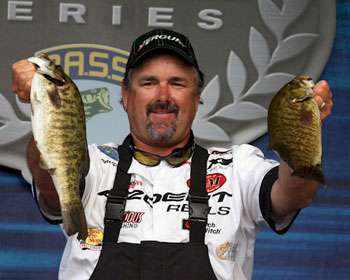
The thought of culling bass during a tournament often brings smiles to the faces of weekend tournament anglers and professional bass anglers alike. Obviously, the first priority is to get a limit of keepers in the boat but after that, the proper way to cull is rarely spoken of.
Elite Series pro Pete Ponds explains that for him, culling strategy is both a means of sound time management and error prevention. "I can't begin to tell you how much time a guy can save over the course of a tournament day by having a really good culling strategy," he says. "All too often, you see guys out on the water that are holding up fish trying to eyeball them, or they'll have a couple of bass in the bottom of the boat trying to size them up. That's not only hard on the fish but also wastes a lot of time and isn't very accurate." When 1/10 of an ounce can spell the difference between making a payday or not, Ponds explains that he has developed his culling strategy through trial-and-error. "If it's a tough bite and I'm pretty sure that I'm only going to catch six or seven fish, I'll use one side of my livewell for most everything I catch," he says.
Ponds says that simply "bumping" or measuring bass to cull is a disaster waiting to happen.In fact, in two different cases at the final regular season Elite Series tournament on Oneida Lake, two anglers made culling errors which cost them their day's weights. To prevent this from occurring and to save time, Ponds uses a culling system with buoy markers to make sure that he won't fail the math test at weigh-in.
"When you're catching great numbers of fish, like we were this year at Oneida Lake, you can get in a panic," he explains. "The way to stop that is to only have five culling buoys in the boat and tag each and every fish. "I make it a point to double-check that every time I cull I don't keep more than the five I'm allowed to have."
The culling system that the Mississippi pro employs keeps track of the bass' weight, and the order in which they need to be released with color coordinated marked buoys. He points out that oftentimes he will use a balance beam to compare two seemingly identical bass. "As a result, particularly at places like Kentucky Lake and Oneida, where you're catching 100 fish a day, you have to use the balance beam a lot. If you get two that are separated by only a couple of ounces, the balance system works great," he says.
Ponds views his balance beam as the ultimate tie-breaker. "If you have two or three fish that are close in weight, the naked eye can't even begin to distinguish the difference," he says. "That's when the balance beam is worth its weight in gold." Just like his digital scales, Ponds treats his balance beam as an important part of his overall system.
"Most guys don't treat the balance beam like it's a critical piece of equipment but it really is," he say. "You have to invest in a quality balance beam so you can be assured of getting accurate weights." Ponds explains that having a well-tuned culling strategy that uses a digital tracking system, color-coordinated buoy markers and a quality balance beam will also decrease stress to the fish caused by over-handling. "You just don't want to handle them too much," he says. "With a good culling system you only have to touch them once — that's really the goal."




